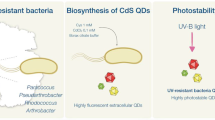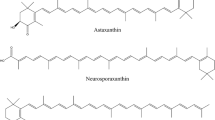Abstract
Reaction centers (RC) from the species Erythrobacter (Eb.) litoralis, Erythromonas (Em.) ursincola and Sandaracinobacter (S.) sibiricus have been purified by LDAO treatment of light-harvesting-reaction center complexes and DEAE chromatography. The content and overall organisation of the RCs' chromophores, determined by linear dichroism (LD) and absorption spectroscopy, are similar to those isolated from anaerobic photosynthetic bacteria. The redox properties of the primary electron donor are pH-independent and very similar to those determined for anaerobic photosynthetic bacteria with midpoint potential values equal to 445 (± 10), 475 and 510 mV for Eb. litoralis, S. sibiricus and Em. ursincola, respectively. The RC purified from Eb. litoralis does not contain bound cytochrome (cyt), whereas RCs isolated from S. sibiricus and Em. ursincola possess a tetraheme cyt c. Each of these tetraheme cyts contains two high potential hemes and two low potential hemes. Their redox properties are very similar, with midpoint potentials equal to 385 (± 10), 305, 40, -40 mV for Em. ursincola and 355, 285, 30, -48 mV for S. sibiricus. At physiological pH, the midpoint potential of the primary electron acceptor (QA) varies with a slope of -60 mV/pH unit. The reduced form of QA presents pK values of 9, 9.8, 10.5 for S. sibiricus, Em. ursincola and Eb. litoralis, respectively. The main difference observed between RCs isolated from anaerobic photosynthetic and from obligate aerobic bacteria is the Emvalues of QA which are 65 to 120 mV higher in the last case. This difference is proposed to be a major reason for the inability of these species to grow under anaerobic photosynthetic conditions.
Similar content being viewed by others
References
Agalidis I, Ivancich A, Mattioli TA and Reiss-Husson F (1997) Characterization of the Rhodocyclus tenuis reaction center. Biochim Biophys Acta 1321: 31–46
Breton J (1974) Contribution à l'étude de l'orientation des pigments dans les membranes photosynthétiques par spectroscopie optique en lumière polarisée. PhD-thesis, Paris
Breton J (1985) Orientation of the chromophores in reaction center of Rhodopseudomonas viridis. Comparison of low temperature linear dichroism spectra with a model derived from X-ray crystallography. Biochim Biophys Acta 810: 235–245
Evans ER, Fleischman DE, Calvert HE, Pyati PV, Alter g and Subba Rao NS (1990) Bacteriochlorophyll and photosynthetic reaction centers in Rhizobium strain BTAi1. Appl Environ Microbiol 56: 3445–3449
Fuerst JA, Hawkins JA, Holmes A, Sly LI, Moore CI and Stackebrandt E (1993) Porphyrobacter neustonnensis gen. nov., sp. nov., an aerobic bacteriochlorophyll-synthesizing budding bacterium from freshwater. Int J Syst Bacteriol 43: 125–134
Harashima K and Takamiya KT (1989) Photosynthesis and photosynthetic appararus In: Harashima K, Shiba T and Murata H (eds) Aerobic Photosynthetic Bacteria, pp 39–72. Japan Scientific Societies Press, Tokyo
Harashima K, Shiba T, Totsuka T, Simidu U and Toga N (1978) Occurrence of bacteriochlorophyll a in a strain of an aerobic heterotrophic bacterium. Agric Biol Chem 42: 1627–1628
Harashima K, Nagagawa M and Murata N (1982) Photochemical activity of bacteriochlorophyll in aerobically grown cells of heterotrophs, Erythrobacter species (OCh114) and Erythrobacter longus (OCh 101). Plant Cell Physiol 23: 185–193
Harashima K, Kawazoe K, Yoshida I and Kamata H (1987) Lightstimulated aerobic growth of Erythrobacter species OCh114. Plant Cell Physiol 28: 365–374
Ivancich A, Kobayashi M, Drepper F, Fathir I, Saito T, Nozawa T and Mattioli TA (1996) Hydrogen-bond interactions of the primary donor of the photosynthetic purple sulfur bacterium Chromatium tepidum. Biochemistry 35: 10529–10538
Joliot P, Béal D and Frilley B (1980) Une nouvelle méthode spectrophotométrique destinée à l'étude des réactions photosynthétiques. J Chim Phys 77: 209–216
Liebetanz R, Hornberger U and Drews G (1991) Organization of the genes coding for the reaction center L and M subunits and B870 antenna polypeptides α and β from the aerobic photosynthetic bacterium Erythrobacter sp. OCh114. Mol Microbiol 5: 1459–1468
Mattioli TA, Lin X, Allen JP and Williams JC (1995) Correlation between multiple hydrogen bonding and alteration of the oxidation potential of the bacteriochlorophyll dimer of reaction centers from Rhodobacter sphaeroides. Biochemistry 34: 6142–6152
Michel H, Epp O and Deisenhofer J (1986) Pigment-protein interactions in the photosynthetic reaction centre from Rhodopseudomonas viridis. EMBO J 5: 2445–2451
Nishimura Y, Mukasa S, Iizuka H and Shimada K (1989) Isolation and characterization of bacteriochlorophyll-protein complexes from an aerobic bacterium, Pseudomonas radiora. Arch Microbiol 152: 1–5
Nitschke W and Dracheva SM (1995) Reaction center associated cytochromes. In: Blankenshop RE, Madigan MT and Bauer CE (eds) Anoxygenic photosynthetic bacteria, pp 775–805. Kluwer Academic Publishers, Dordrecht, The Netherlands
Okamura K, Takamiya KT and Nishimura M (1985) Photosynthetic electron transfer system is inoperative in anaerobic cells of Erythrobacter species strain OCh114. Arch Microbiol 142: 12–17
Okamura K, Mitsumori F, Ito O, Takamiya KT and Nishimura M (1986) Photophosphorylation and oxidative phosphorylation in intact cells and chromatophores of an aerobic photosynthetic bacterium, Erythrobacter sp. strain OCh114. J Bacteriol 168: 1142–1146
Prince R and Dutton LP (1978) Protonation and the reducing potential of the primary electron acceptor. In: Clayton RK and Sistrom WR (eds) The Photosynthetic Bacteria. Plenum Press, New York
Shiba T and Simidu U (1982) Erythrobacter longus gen. nov., sp. nov., an aerobic bacterium which contains bacteriochlorophyll a. Int J Syst Bacteriol 32: 211–217
Shiba T and Harashima K (1986) Aerobic photosynthetic bacteria. Microbiol Sci 3: 376–378
Shiba T, Simidu U and Taga N (1979) Distribution of aerobic bacteria which contain bacteriochlorophyll a. Appl Environ Microbiol 38: 43–45
Shiba T, Shioi Y, Takamiya KI, Sutton DC and Wilkinson CR (1991) Distribution and physiology of aerobic bacteria containing bacteriochlorophyll a on the East and West coasts of Australia. Appl Environ Microbiol 57: 295–300
Shimada K (1995) Aerobic Anoxygenic phototrophs. In: Blankenshop RE, Madigan MT and Bauer CE (eds) Anoxygenic Photosynthetic Bacteria, pp 105–122. Kluwer Academic Publishers, Dordrecht, The Netherlands
Shimada K, Hayashi H and Tasumi M (1985) Bacteriochlorophyllprotein complexes of aerobic bacteria, Erythrobacter longus and Erythrobacter sp. OCh114. Arch Microbiol 143: 244–247
Takamiya K and Okamura K (1984) Photochemical activities and photosynthetic ATP formation in membrane preparation from a facultative methylotroph, Protaminobacter ruber strain NR-1. Arch Microbiol 140: 21–26
Takamiya K, Iba K and Okamura K (1987) Reaction center complex from an aerobic photosynthetic bacterium Erythrobacter species OCh114. Biochim Biophys Acta 890: 127–133
Takamiya K, Arata H, Shioi Y and Doi M (1988) Restoration of the optimal redox state for the photosynthetic electron transfer system by auxiliary oxidants in an aerobic photosynthetic bacterium, Erythrobacter sp. Och 114. Biochim Biophys Acta 935: 6–33
Tapie P, Haworth P, Hervo G and Breton J (1982) Orientation of the pigments in the thylakoid membrane and in the isolated chlorophyll–protein complexes of higher plants III: A quantitative comparison of the low-temperature linear dichroism spectra of thylakoids and isolated pigment–protein complexes. Biochim Biophys Acta 682: 339–344
Thomas PE, Ryan D and Lewin W (1976) An improved staining procedure for the detection of the peroxidase activity of cytochrome P-450 on sodium dodecyl sulfate polyacrylamide gels. Analyt Biochem 75: 168–176
Verméglio A and Clayton RK (1976) Orientation of chromophores in reaction centers of Rhodopseudomonas sphaeroides. Evidence for two absorption bands of the dimeric primary electron donor. Biochim Biophys Acta 449: 500–515
Yurkov V and Gorlenko VM(1990) Erythrobacter sibiricus sp. nov., a new freshwater aerobic bacterial species containing bacteriochlorophyll a.Microbiology (Engl. Transl. Mikrobiologiya) 59: 85–89
Yurkov V and Gorlenko VM (1992) A new genus of freshwater aerobic, bacteriochlorophyll a-containing bacteria, Roseococcus gen. nov. Microbiology (Engl. Transl. Mikrobiologiya) 60: 628–632
Yurkov V and Gorlenko VM (1993) New species of aerobic bacteria from the genus Erythromicrobium containing bacteriochlorophyll a.Microbiology (Engl. Transl. Mikrobiologiya) 61: 163–168
Yurkov V and Van Gemerden H (1993a) Impact of light/dark regime on growth rate, biomass formation and bacteriochlorophyll synthesis in Erythromicrobium hydrolyticum. Arch Microbiol 159: 84–89
Yurkov V and Van Gemerden H (1993b) Abundance and salt tolerance of obligately aerobic, phototrophic bacteria in a microbial mat. Neth J Sea Res 31: 57–62
Yurkov V and Beatty JT (1998) Isolation of aerobic anoxygenic photosynthetic bacteria from black smoker plume waters of the Juan de Fuca Ridge in the Pacific Ocean. Appl Environ Microbiol 64: 337–341
Yurkov V, Gad'on N, Angerhofer A and Drews G (1994) Lightharvesting complexes of aerobic bacteriochlorophyll-containing bacteria Roseococcus thiosulfatophilus, RB3 and Erythromicrobium ramosum, E5 and the transfer of excitation energy from carotenoids to bacteriochlorophyll. Z Naturforsch (in Engl.) 49(c): 579–586
Yurkov V, Jappé J and A Verméglio (1996) Tellurite resistance and reduction by obligately aerobic photosynthetic bacteria. Appl Environ Microbiol 62: 4195–4198
Yurkov V, Stackebrandt E, Buss O, Verméglio A, Gorlenko V and Beatty JT (1997) Reorganization of the genus Erythromicrobium. Description of 'Erythromicrobium sibiricum' and 'Erythromicrobium ursincola' as members of two new independent genera: Sandaracinobacter andErythromonas. Int J Syst Bacteriol 47: 1172–1178
Author information
Authors and Affiliations
Rights and permissions
About this article
Cite this article
Yurkov, V., Menin, L., Schoepp, B. et al. Purification and characterization of reaction centers from the obligate aerobic phototrophic bacteria Erythrobacter litoralis, Erythromonas ursincola and Sandaracinobacter sibiricus. Photosynthesis Research 57, 129–138 (1998). https://doi.org/10.1023/A:1006087403692
Issue Date:
DOI: https://doi.org/10.1023/A:1006087403692




